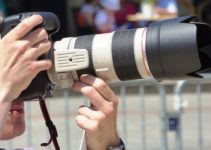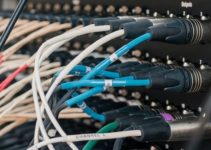Birdwatching is a great hobby, but it can be frustrating too when your binoculars are wobbly and you cannot tell if you are looking at a Dark-eyed Junco or a Bachman’s Sparrow. Wobbly or shaky images can be caused by long-distance zooms coupled with slight body movement.
- EDITOR’s TOP3
- Canon 18×50 – EDITOR’s PICK
- Fujinon Techno Stabi TS1440 – EDITOR’s PICK
- Canon 10×30 – EDITOR’s PICK
- Fujinon Techno-Stabi TS1228
- Canon 10×42 L
However, first, let’s dive in with our top 3 candidates for best image stabilized binoculars for birding
Best Binoculars for Birding
EDITOR’s PICK |
|---|
1. Canon 18x50 IS All-Weather Binoculars |
| «EDITOR’s PICK» |
| Best overall package |
| Our rating: ⭐⭐⭐⭐⭐ |
 |
We really like these compact Canon binoculars for birding for their great stabilization but also the affordable package they come in. |
| Pros: — Great package with lots of useful accessories; — High 18x magnification and 50 resolution; — Great internal optics with a low MTF distortion (modulation transfer function); — 3.7 degree angle of view lets you see more of the scene; — Reasonable weatherproofing. Cons: — Heavy at just under 2.7 pounds. |
2. Fujinon Techno Stabi TS1440 |
| «EDITOR’s PICK» |
| Best for price/performance |
| Our rating: ⭐⭐⭐⭐⭐ |
 |
Affordability is important when choosing which higher - end binoculars are best for birding – these Fuji 14x40 babies fit the bill and your pocket. |
| Pros: — Good optics; — Really good stabilization; — Excellent waterproofing; — Mains power option for long sessions. Cons: — Also heavy at just over 2.7 pounds. |
3. Canon 10x30 IS II Binoculars |
| «EDITOR’s PICK» |
| Best compact model |
| Our rating: ⭐⭐⭐⭐⭐ |
 |
A rugged design, coupled with very lightweight and small size, makes these Canons great for backpacking. Add in good magnification and a reasonable cost. Taken together that makes these a great choice for long-distance birding. |
| Pros: — Good internal optics; — A useful amount of stabilization; — Low cost; — Low weight. Cons: — Not as effective at long distance viewing. |
Criteria for best binoculars for birding

There are all kinds of criteria when selecting the best image stabilized binoculars for birdwatching. In our opinion, here are the key ones:
Optical performance and parameters
This is down to magnification, and objective diameter, which dictates the sharpness or resolution. So, for example, our #1 pick of the Canon 18×50, magnifies by 18 times and has a resolution figure of 50. That’s like a really good camera zoom in. The #3 pick of the Canon 10×30, magnifies by 10 times and has a resolution figure of 30. That’s also good but won’t be as clear.
Typical birding models will have specs like the ones below
- 8×42
- 10×50
- 8×32
- 10×42
The quality of the lenses (how accurately they are ground) also makes a difference and also the use of special lens coatings to reduce flare etc.
Type of stabilization
This technique falls into three categories
Active mechanical (battery-powered offset movement of lenses or prisms). This compensates mechanically.
Passive mechanical (gyroscopic stabilization). This uses the gyroscope to physically stabilize the binoculars.
Digital (motion stabilization based on a static reference point). This technique is only found in digital binoculars.
Weight and size
All large object diameter binoculars tend to be bulkier and heavier. Image stabilization models for amateur birding tend to be heavier due to the stabilization technology. If you put the two together, you get heavier and bigger than normal binoculars and some are a bit too much for children – you’d need to find something a bit lightweight. Small binoculars are generally better for kids.
Glasses
Binoculars can be awkward when wearing glasses. Some models are better than others for glasses wearers.
Cost
Then, of course, there is the cost. Don’t just go by a headline sticker price – there are packages which are very affordable, because lots of accessories come with them too. You don’t have to pay top dollar either, just because some review tells you that you should . There are perfectly good models out there which are more suited to a beginner who doesn’t need a high-cost device. Finally, buying online is topical right now. We recommend considering a less well-known brand as well as a popular one. We don’t like to make a list that only looks at commonly rated models with top reviews. Everyone is different and has different needs and budgets.
Now let’s look in detail at five candidates for crowning with the title of the best-stabilized binoculars for bird watching.
Best Image Stabilized Binoculars for Birding
1. Canon 18×50 Image Stabilization All-Weather Binoculars – Bundle
Best overall package

If you have the cash and are serious about birdwatching, this Canon bundle based on the 4624A002 porro prism model supplies just what you need. The magnification and sharpness are terrific, and you get battery powered stabilization of up to 0.7 degrees. It comes with a comprehensive package including a lens hood and tripod and we really like the three supplied filters. One purchase and you are ready to go find that Loon.
- Great package with lots of useful accessories including Case, Neck Strap, Batteries, Filter Kit for UV, Circular Polarizer and Fluorescent, Lens Hood, Tripod, etc.
- High 18x magnification and 50 resolution.
- Great internal optics with a low MTF distortion (modulation transfer function)
- 3.7 degree angle of view lets you see more of the scene.
- Reasonable weatherproofing.
- Heavy at just under 2.7 pounds.
Verdict: If you have the money to spend on serious birdwatching, this is a great way to spend it.
2. Fujinon Techno Stabi TS1440
Best for price/performance

These lower priced binoculars from the folks at Fuji use 4 × AA batteries to deliver a class leading 5 degrees of stabilization at up to 14x magnification.
If affordability is the most important thing to you when choosing which binoculars are best for birding – this Fuji 14×40 set might fit the bill and your pocket a little more so than the Canons. You get ±5 degrees of Stabilization. They also come with really good waterproofing and the neat feature of a mains power option to save battery life. All in all a really good solution for watching Cardinals or Blue Jays feeding and preening (we mean the birds, not the sports teams or their players – although they would be good binoculars for that too).
- Good optics.
- Really good stabilization.
- Excellent waterproofing.
- Mains power option for long sessions.
- Also heavy at just over 2.7 pounds.
Verdict: If you are anywhere around water and on a long day waiting for the sight of an Audubon’s Shearwater or hoping for a Black-bellied Whistling-Duck to actually whistle, these are possibly the binoculars to go for.
3. Canon 10×30 IS Image Stabilization II Binoculars
Best compact model

If you are looking for an even lower cost, rugged design, which is a lightweight and smaller size, these Canons are well worth considering. Magnification is more modest at 10x but battery-powered stabilization is still good at +/- 1 degree and – possibly more to the point – they are less than half the cost of our first two models. Then, add the fact these are just 21.2 ounces and you have a very attractive combination.
- Good internal optics.
- A useful amount of stabilization.
- Low cost.
- Low weight.
- Not as effective at long distance viewing.
Verdict: If your bird watching ambitions and your budget are more modest, these Canons are a logical alternative to our first and second choices.
4. Fujinon Techno-Stabi TS1228 Image Stabilization Binocular
Best for beginners and kids

Our next suggestion on the list is this lightweight, compact and lower cost 12×28 model from Fuji Film. We think it is ideal for beginners or kids and despite the lower price, you still get good looking pictures and also ±3 degrees of battery powered image stabilization. It uses a compact CR2 lithium battery rather than the bulky but easy to buy anywhere and potentially rechargeable AAs or AAAs of other models on our list. A mixed blessing, although up to 12 hours battery use is possible.
- Decent optics despite the price.
- Great stabilization at this price point.
- Very lightweight at just 14.9 ounces.
- Internal optics not quite equal to Canon.
- We’re not sure about the battery choice.
Verdict: Ideal if you want something reasonably priced which still gives great levels of stabilization.
5. Canon 10×42 L Image Stabilization Waterproof Binoculars
Best for when the going gets really wet

Our final model is really one which we recommend when you are birdwatching while boating. These Canons are fully waterproof and all you need to do is add a flotation strap and you have peace of mind. No point recording your first Spatula discors if you lose your expensive and much loved binoculars overboard and then you need to spend twice to get a new pair.
- Decent performance.
- Fully waterproof.
- Canon’s usual good internal optics.
- There are better Canons (and better Fujis).
Verdict: A specialized model that makes sense if you are out in the wet.
Stabilized Binoculars for Birding

There are 8 types of Thrushes alone in North America, so if you really want to tell a Bicknell’s Thrush from a Common Wood Thrush, then shaky images don’t help. Plus, you don’t want to feel sick trying. So, we have chosen 5 practical and sensible image stabilized binoculars for bird watching that will do the job nicely.
We hope you have found this list and review useful and please let us know your thoughts in the comments section. Thanks for reading and hope you see that Boat-tailed Grackle.







You mention MTF in the article – what’s that all about?
Glad you asked. Whenever you have any optical design with light passing through it, each time the light enters or leaves the glass, there’s the opportunity for slight bending, spreading or other distortions to happen. The MTF is the modulation transfer function. In plain English, it is a measurement of how much distortion (modulation) happens to the light as it passes (transfers) through the different lenses, especially at the boundaries between one lens and another. MTF is usually not so much an issue with light going through the centre of a lens but it is a bigger issue as you get to the outer edges. One of the big factors determining how good (and how expensive) binoculars are is the MTF. However, it is a complex topic a consumer manufacturer usually doesn’t discuss with the public.
Canon talks about using a “Porro prism” – what’s that all about?
That means they use a geometric prism with right-angled triangular end faces which means the binocular body has a zig-zag shape. It’s a very light-efficient design but a bit bulky.